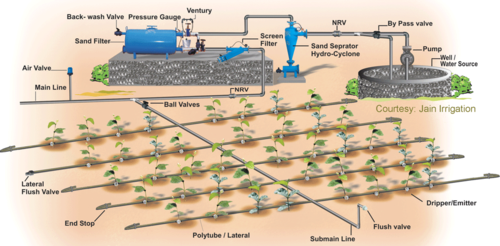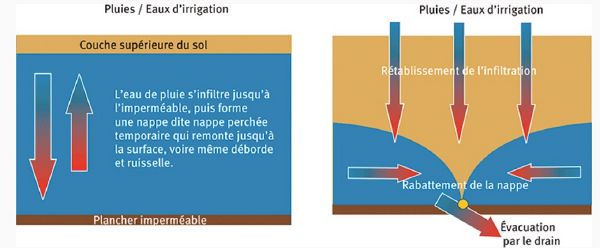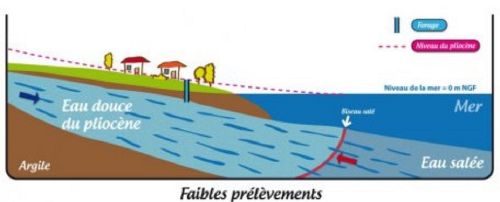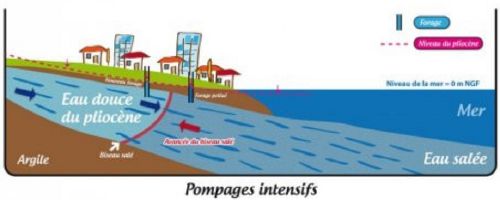 Irrigation, effluent management, ZNT, useful water reserve, drainage
Irrigation, effluent management, ZNT, useful water reserve, drainage

In recent years, summer drought seems to have become a constant in mainland France, while violent storms are also more frequent. Climate forecasts predict that rainfall will become more irregular and more unevenly distributed. So we'll have to manage both the lack and the excess of water.
Flooding also causes major damage to crops, erode soil and reduce water quality. Irrigation, on the other hand, is increasingly being questioned and criticised. Irrigation accounts for most of the water used in agriculture, which also includes watering livestock and cleaning machinery and equipment.
In addition to the "quantity of water" approach (lack or excess), we need to take into account water quality, which is linked to the quality of drinking water, toeutrophication of natural environments, salinisation of agricultural land, etc.
Water management is a complex issue because it involves a large number of interdependent players over large areas. Water management is a complex issue because it involves the interdependence of many players over large areas, and is best thought of on thescale of a catchment area rather than that of a single municipality or agricultural cooperative.
Irrigation
The objectives of irrigation
- To ensure and maintain a good level of yield in the event of drought,
- Toimprove productquality (seeds, market gardening, horticulture, orchards, etc. or contract crops)[1],
- Simultaneousfertilisation and improved mobilisation of fertiliser by plants.
There are different irrigation tools and methods (pivot, drip, etc.), which also differ in terms of water use efficiency, costs and energy use.
Reducing water consumption
There are avoidance strategies that involve choosing early varieties and sowing dates that allow the most drought-sensitive phenological stages to be postponed. In this way, sensitive phases (flowering, for example) take place at a time when water is available[1].
There are also avoidance strategies, which involve reducing the crop's need for water. For example, by :
- Reducing sowing density.
- Reducing nitrogen fertilisation.
- Soil conservation agriculture: improves water infiltration into the soil and therefore water retention and groundwater replenishment, encourages the development of mycorrhizae and root exploration.
- Agroforestry and hedgerow planting: similarly, improve water infiltration into the soil and therefore water retention and groundwater replenishment, and reduce evaporation losses thanks to the shade provided by the canopy and its windbreak effect. The deep roots of trees also draw water more deeply if care is taken not to let them compete with other crops.
Theprecision irrigation system, which uses technologies such as GPS and variable flow irrigation, uses less water and energy by adapting to varying needs within the same plot.
Irrigation issues and criticisms
With more frequent droughts, water tables and rivers are filling up less and less and are being used more and more. This raises the question of the sustainable use of their water resources. Maize growing in particular has come in for a lot of criticism, as it is very widespread in France and requires water during the driest periods.
Solutions for finding water elsewhere are criticised and debated, such as open-air water reservoirs, which disrupt natural environmentsCarluer[2] and lose a lot of water through evaporation.
It is also possible to replenish aquifers artificially using river water, or to reuse wastewater after treatment. The latter solution is not widely used in France, however, because of "regulatory, technical and economic" obstacles[1].
Some countries are already using seawater desalination, but it is very expensive, requires a lot of fossil fuels and is harmful to the environment.
Drainage

The main aim of drainage is to make soils with low permeability or an impermeable floor suitable for agriculture. Itimproves the yield potential of hydromorphic soils. Drainage is also one of the measures used to remedy salinisation by rinsing plots of land, and to combat surface water pollution, as it makes it possible to "transform diffuse pollution into point source pollution"[1] and therefore to purify water more easily, in one place, and at a lower cost.
Drainage has sometimes been abused and has led to a sharp reduction in the area of wetlands, which we now know are essential for the natural regulation of water stocks and the water cycle. Generally speaking, it is better to drain sparingly and gradually so as not to completely dry out the plot.
Based on an article published in Sciences, Eaux & TerritoiresVincent[3] drainage techniques are well developed and require no particular innovation. A well-designed drainage system can be used for a very long time, tens or even hundreds of years, and is passed on with the land.
Water quality and pollution
Agricultural activities have a high potential for polluting water, which is dangerous for natural environments and for drinking water supplies. That's why water quality is subject to extensive regulation.
These regulations target nitrates and pesticides in particular. In Nitrate Vulnerable Zones farmers must comply with specific regulations on the use ofnitrogen. In the rest of the country, measures are voluntary. As for pesticides, they are subject to No-Treatment Zones around watercourses and water catchment areas. The size of these zones depends on each product. They can be put to good use by growing species that require little fertiliser or weedkiller, such as hemp or silphia.
According to a 2016 report by the French General Council for Food, Agriculture and Rural Areas (CGAAER), improving water quality by reducing the use of inputs relies on innovation in"plant breeding, precision agriculture, biocontrol and sustainable weed management[4]
Erosion
Soil erosion by water refers to the detachment and transport of soil particles by rainwater and run-off. Soil erosion (which can also be caused by wind) is one of the greatest threats to agricultural soils, which are degrading 10 to 40 times faster than they are regeneratingPimentel[5].
The erosivity of soils depends on their nature, their capacity for infiltration and their water saturation, as well as whether they are bare or covered with vegetation.
The main consequences of erosion are :
- Loss of surface and fertile soil layers, loss of nutrients.
- Reduction in rooting depth.
- Reduction in useful water reserves.
In addition, the material washed away ends up in watercourses and reduces water quality.
Measures to combat erosion include :
- Permanent soil cover.
- Enriching the soil with organic matter (mulch, compost, etc).
- Planting hedges or grass strips.
- No tillage, semi-direct tillage.
- Working the soil along contour lines.
- Terrace-type landscaping.
Salinisation
Soil salinisation is defined by the FAO as "the phenomenon of anincrease in water-soluble salts in the soil". These can include sodium, potassium, magnesium, calcium and chlorine.
Salinisation affects the physiological functions of plants, and therefore crop yields, or even makes farming impossible on the land affected. When most of the salts present are sodium Na+, the soil is said to be sodic. In this case, the structure of the soil and its ability to infiltrate water are severely disrupted.
Salinisation is a major threat to agricultural soils worldwide, particularly in arid and semi-arid climates. France is little affected today, but the phenomenon is set to spread, as it is closely linked to irrigation management, drought and rising sea levels.
===Origins of soil salinisation
===

Natural :
- Sea spray and aerosols, or even marine incursions on land and into aquifers (Camargue delta, for example).
- Dissolution of salty rocks and sediments by water and infiltration of salt-laden water.

Anthropogenic:
- Irrigation with poor quality water.
- Irrigation in insufficient volume to leach out the salts.
- Disruption of aquifer balance and upwelling of marine water into the water table (poor management of water tables, drought, deforestation, etc.).
Key factors in the fight against salinisation
- Monitor the quality of irrigation water.
- Wash plots with fresh water and drain to remove salts.
- Limit evaporation in favour of infiltration (organic amendments, mulching, drip irrigation*).
- Drain deeply to maintain a surface water table outside the root zone.
- Apply chemical amendments to sodic soils (gypsum, sulphide and sulphuric acid[6]).
- Noteon drip irrigation: In the short term, drip irrigation is a good solution for salt-laden irrigation water, because the water supply is reduced, which means the salt supply is also reduced. However, in the long term this method seems to cause salt accumulation in the root zone because it does not allow soil leachingZ[7]
- ↑ 1.0 1.1 1.2 1.3 AUTISSIER Pierre, JOURDIER Geneviève (March 2022) Parangonnage sur les techniques et pratiques innovantes de gestion de l'eau en agriculture - Rapport n° 21045 https://www.vie-publique.fr/sites/default/files/rapport/pdf/285442.pdf
- ↑ N., Babut M., Belliard J., Bernez I., Burger-Leenhardt D., Dorioz J.M., Douez O., Dufour S., Grimaldi C., Habets F., Le Bissonnais Y., Molénat J., Rollet A.J., Rosset V., Sauvage S., Usseglio-Polatera P., Leblanc B. (2016). CUMULATED IMPACT OF WATER WITHDRAWALS ON THE AQUATIC ENVIRONMENT - Expertise scientifique collective. Summary of the collective scientific expertise carried out by Irstea, in partnership with INRA, at the request of the French Ministry of the Environment, Energy and the Sea, with the support of Onema. https://expertise-impact-cumule-retenues.inrae.fr/les-rapports/
- ↑ Bernard , Principes techniques et chiffres du drainage agricole. De la tuyautique à l'hydro-diplomatie, Sciences Eaux & Territoires 2020/2 (Issue 32), pages 8 to 15, https://www.cairn.info/revue-sciences-eaux-et-territoires-2020-2-page-8.htm?contenu=article
- ↑ "Colas-Belcour F., Renoult R., Vallance M. (25 May 2016) Report on water quality in agriculture, CGAAER. https://agriculture.gouv.fr/synthese-sur-la-qualite-de-leau-en-agriculture.
- ↑ David (2006) Soil Erosion: A Food and Environmental Threat February, Environment Development and Sustainability 8(1):119-137 DOI:10.1007/s10668-005-1262-8 https://www.researchgate.net/publication/225755338_Soil_Erosion_A_Food_and_Environmental_Threat
- ↑ FAO, Salt-affected soils, Soil Information Portal, consulted online 24/08/2022 https://www.fao.org/soils-portal/soil-management/gestion-des-sols-a-problemes/gestion-des-sols-affectes-par-le-sel/more-information-on-salt-affected-soils/fr/
- ↑ . Wang,B. Fan,L. Guo (2018) Soil salinization after long-term mulched drip irrigation poses a potential risk to agricultural sustainability, European Journal of Soil Science, 05 October 2018 https://doi.org/10.1111/ejss.12742.
- FAO 2017. Voluntary Guidelines for Sustainable Soil Management Food and Agriculture Organization of the United Nations Rome, Italy Online: https://www.fao.org/3/bl813e/bl813e.pdf
- Kloppmann W., Bourhane A., Schomburgk S., Asfirane F. (2011), Salinisation des masses d'eau en France : du constat au diagnostic. Report BRGM/RP-60186-FR. Online: https://infoterre.brgm.fr/rapports/RP-60186-FR.pdf
- Zones vulnérables - Métropoles, updated on 20 December 2020 Online: https://www.data.gouv.fr/fr/datasets/zones-vulnerables-metropole/
- https://itrade.gov.il/france/2021/10/25/lirrigation-de-precision/